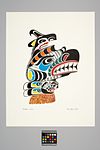Sea Raven, Gwa-Wis
About this object
History of use
Northwest Coast print making is a relatively new art form, which began in the late 1940's, but did not develop until the late 1960's. The establishment of the Northwest Coast Indian Artists Guild, in 1977, aided the implementation of standards in limited addition runs and various aspects of quality control. Silk-screen prints have been used to portray traditional and contemporary themes, as well as, to make personal statements. Kwakwaka'wakw artists have, in general, preferred to work with traditional crest designs and mythical themes. More colours are used by Kwakwaka'wakw artists than are used by northern Northwest Coast artists, and the images are composed of many small elements combining into relatively realistic forms.
Narrative
Nb3.1335 to Nb3.1343 were given to Audrey Hawthorn in 1973. This collection of Henry Speck prints is from an unnumbered collection probably printed in the 1960's.
Cultural context
contemporary art
Physical description
Configurative design of sea raven in Kwakwaka'wakw style. Image of mask with the head of a raven and the heads of other creatures on top of the head. Under the raven, there is human face which is on top of grass. The grass is red, yellow, and black. Most of the design is in black including dashes on the raven and all outlining. There are multi-coloured split-u's and orange, blue, and green u forms. All the mouths are open with teeth and red outlining. Raven has red nostrils in ovoid shapes. Black inscription below image. The print is on vertically rectangular, off-white paper.
